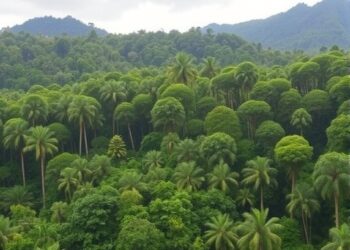In October 2013, Gerard Talavera, a researcher from the Botanical Institute of Barcelona at CSIC, made a surprising discovery of Painted Lady Butterflies on the Atlantic beaches of French Guiana—a species not typically found in South America. This unusual sighting prompted an international study to investigate the origin of these butterflies.
In October 2013, Gerard Talavera, a researcher from the Botanical Institute of Barcelona at CSIC, made a surprising discovery of Painted Lady Butterflies on the Atlantic beaches of French Guiana—a species not typically found in South America. This unusual sighting prompted an international study to investigate the origin of these butterflies.
A Combination of Novel Techniques Solves the Enigma
Using innovative multidisciplinary tools, the research team co-led by Gerard Talavera from the Institut Botànic de Barcelona (IBB, CSIC-CMCNB), Tomasz Suchan from the W. Szafer Institute of Botany, and Clément Bataille, associate professor inthe Department of Earth and Environmental Sciences at the University of Ottawa – with Megan Reich, a postdoctoral researcher from the Department of Biology at uOttawa, Roger Vila and Eric Toro Delgado, scientists from the Institute of Evolutionary Biology (IBE, CSIC-UPF) and Naomi Pierce, a professor of Biology in the Department of Organismic and Evolutionary Biology at Harvard University – embarked on a scientific mission to track the journey and origin of those mysterious Painted Ladies.
First, the research team reconstructed wind trajectories for the period preceding the arrival of these butterflies in October 2013. They found exceptionally favorable wind conditions that could support a transatlantic crossing from western Africa, opening the possibility that those individuals might have flown across the entire ocean.
After sequencing the genomes of these individuals and analyzing them in comparison to populations globally, researchers discovered that the butterflies had a closer genetic relatedness to African and European populations. This result eliminated the likelihood of these individuals coming from North America, thereby reinforcing the hypothesis of an oceanic journey.
Researchers leveraged a unique combination of next-generation molecular techniques. They sequenced the DNA of pollen grains carried by these butterflies. They identified two species of plants that only grow in tropical Africa indicating that the butterflies nectared on African flowers before engaging into their transatlantic journey. They analyzed hydrogen and strontium isotopes in the butterflies’ wings, a chemical signal that acts as a “fingerprint” of the region of natal origin. Combining isotopes with a model of habitat suitability for larval growth revealed potential natal origin in western Europe, possibly France, Ireland, the United Kingdom, or Portugal.
Dr. Bataille underlines the methodological novelty of this study: “It is the first time that this combination of molecular techniques including isotope geolocation and pollen metabarcoding is tested on migratory insects. The results are very promising and transferable to many other migratory insect species. The technique should fundamentally transform our understanding of insect migration”.
“We usually see butterflies as symbols of the fragility of beauty, but science shows us that they can perform incredible feats. There is still much to discover about their capabilities,” emphasizes Roger Vila, a researcher at the Institute of Evolutionary Biology (CSIC-Pompeu Fabra University) and co-author of the study.
Buoyed by the Winds
The researchers assessed the viability of a transatlantic flight by analyzing the energy expenditure for the journey. They predicted that the flight over the ocean, lasting 5 to 8 days without stops, was feasible due to advantageous wind conditions. “The butterflies could only have completed this flight using a strategy alternating between active flight, which is costly energetically, and gliding the wind. We estimate that without wind, the butterflies could have flown a maximum of 780 km before consuming all their fat and, therefore, their energy,” comments Eric Toro-Delgado, one of the article’s co-authors.
The Saharan air layer is emphasized by researchers as a significant aerial route for dispersion. These wind currents are known to transport large amounts of Saharan dust from Africa to America, fertilizing the Amazon. This study now shows that these air currents are capable of transporting living organisms.
The Potential Impact of Migrations in the Context of Global Change
This finding indicates that natural aerial corridors connecting continents may exist, potentially facilitating the dispersal of species on a much larger scale than previously imagined.
“I think this study does a good job of demonstrating how much we tend to underestimate the dispersal abilities of insects. Furthermore, it’s entirely possible that we are also underestimating the frequency of these types of dispersal events and their impact on ecosystems,” comments Megan Reich, a Postdoctoral Fellow at the University of Ottawa who also coauthored the study.
Gerard Talavera, the study’s lead researcher, adds, “Throughout history, migratory phenomena have been important in defining species distributions as we observe them today.”
Researchers emphasize that due to global warming and changing climate patterns, we may witness more notable changes and a potential increase in long-distance dispersal events. This could significantly impact biodiversity and ecosystems worldwide. “It is essential to promote systematic monitoring routines for dispersing insects, which could help predict and mitigate potential risks to biodiversity resulting from global change,” concludes Gerard Talavera.
The incredible voyage of these animals was featured in the article titled “A trans-oceanic flight of over 4,200 km by painted lady butterflies” in Nature Communications journal on June 25, 2024.
Journal
Nature Communications
Method of Research
Case study
Subject of Research
Animals
Article Title
A trans-oceanic flight of over 4,200 km by painted lady butterflies
Article Publication Date
25-Jun-2024




